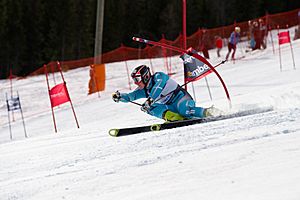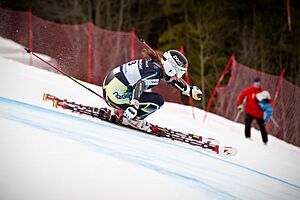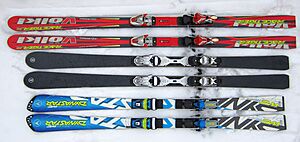Giant slalom facts for kids
Giant slalom (often called GS) is an exciting alpine skiing and alpine snowboarding sport. In GS, skiers race down a mountain between special poles called gates. These gates are placed farther apart than in slalom races, but closer than in Super-G races.
Giant slalom and slalom are known as "technical events" in ski racing. This means they focus more on turns and skill than on pure speed. Other events like Super-G and downhill are called "speed events." Technical races usually have two runs. Skiers race on slightly different courses on the same slope, and their times are added together.
Contents
The Race Course
For men, a giant slalom course usually drops between 250 and 450 meters (about 820 to 1,476 feet). For women, the drop is between 250 and 400 meters (about 820 to 1,312 feet).
The course has a certain number of gates. Men's courses have 56 to 70 gates, while women's courses have 46 to 58 gates. The course is designed so that skiers make many turns. For example, on a course with a 300-meter (984-foot) drop, adult racers might make 33 to 45 turns.
How Fast Do Skiers Go?
Giant slalom isn't the fastest ski event, but skiers still go very quickly! A well-trained racer can reach average speeds of about 40 kilometers per hour (about 25 miles per hour).
What Equipment Do They Use?
The skis used for giant slalom are special. They are shorter than skis used for Super-G and downhill races, but longer than slalom skis.
To make the sport safer, the International Ski Federation (FIS) made some changes to equipment rules. For the 2003–04 season, they said GS skis had to have a certain turning radius (how much the ski naturally wants to turn). They also set minimum ski lengths: 185 cm (about 6 feet) for men and 180 cm (about 5 feet 11 inches) for women. The maximum height of the boot above the snow was also set at 55 mm (about 2.2 inches).
More changes came in 2007–08. The minimum turning radius for men's GS skis increased to 27 meters (about 89 feet) and to 23 meters (about 75 feet) for women's skis. The skis also had to be a bit wider in the middle. The maximum boot height was lowered to 50 mm (about 2 inches). Some top skiers, like Ted Ligety and Lindsey Vonn, often used skis with even bigger turning radii.
In 2012–13, the FIS made the turning radius even larger, to 35 meters (about 115 feet), and the minimum length for men's skis to 195 cm (about 6 feet 5 inches). Many athletes didn't like this change. Some argued that the studies used to make these rules weren't very scientific. They pointed out that knee injuries had actually been going down since the 1990s, when carving skis (which turn more easily) became popular.
History of Giant Slalom
The very first giant slalom race took place in Italy on January 20, 1935, at a place called Mottarone. A month later, another giant slalom was held in Italy's Dolomite mountains.
Giant slalom became a part of the World Championships in 1950 in Aspen, Colorado. It then joined the Winter Olympics in 1952 in Oslo, Norway. Since then, GS has been in every World Championship and Olympic Games.
At first, giant slalom was just one race run. But in 1966, a second run was added for men at the World Championships. This became part of the Olympics in 1968. Women's races got a second run at the World Championships in 1978 and at the Olympics in 1980.
Originally, the Olympic GS races sometimes took place over two days. However, since the 1988 Olympics, giant slalom has always been a one-day event.
|
See also
 In Spanish: Eslalon gigante para niños
In Spanish: Eslalon gigante para niños




